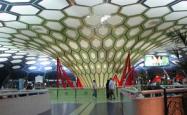园林绿化设计图图案
Title: The Art and Science of Landscape Design
Landscape design is a harmonious blend of art and science, aiming to create outdoor spaces that are aesthetically pleasing, functional, and sustainable. It encompasses various elements such as plants, hardscape features, water bodies, and architectural structures.
The design process begins with a thorough analysis of the site, considering factors like soil type, climate, topography, and existing vegetation. This analysis forms the foundation for developing a design concept that meets the client's needs and integrates seamlessly with the surrounding environment.
1.
Plants:
Selecting appropriate plant species based on factors like growth habits, color, texture, and seasonal interest is crucial. A welldesigned planting scheme considers the visual impact of plants throughout the year and ensures biodiversity.
2.
Hardscape Features:
Elements like pathways, patios, walls, and decks provide structure to the landscape and facilitate movement within the space. Material selection should take into account durability, aesthetics, and compatibility with the overall design theme.
3.
Water Features:
Ponds, fountains, and streams add a dynamic dimension to the landscape, attracting wildlife and creating a soothing ambiance. Proper circulation, filtration, and maintenance are essential for the longevity of water features.
4.
Architectural Elements:
Structures such as pergolas, gazebos, and arbors serve as focal points and provide shelter or shade. Their design should complement the overall style of the landscape and enhance its functionality.
1.
Unity:
A cohesive design ensures that all elements work together harmoniously to create a unified whole.
2.
Balance:
Symmetrical or asymmetrical arrangements achieve visual balance and prevent any single element from overpowering the design.
3.
Scale and Proportion:
Proper scaling of elements relative to one another and the surrounding environment creates a sense of harmony and proportion.
4.
Rhythm and Repetition:
Repeating patterns and rhythms guide the viewer's eye through the landscape, creating a sense of movement and continuity.
5.
Emphasis:
Focal points draw attention and create visual interest, anchoring the design and providing a sense of hierarchy.
6.
Sustainability:
Implementing ecofriendly practices such as water conservation, native plant selection, and soil preservation ensures the longterm health and resilience of the landscape.
1.
Site Limitations:
Addressing issues like limited space, poor drainage, or steep slopes requires innovative solutions such as terracing, raised beds, or stormwater management systems.
2.
Climate Considerations:
Designing landscapes that thrive in specific climatic conditions necessitates careful plant selection, irrigation planning, and microclimate management.
3.
Maintenance Requirements:
Developing lowmaintenance landscapes reduces the need for constant upkeep, incorporating strategies like droughttolerant plants, automated irrigation systems, and minimalistic design.
Landscape design is a multifaceted discipline that combines artistic vision with scientific principles to create outdoor environments that inspire, rejuvenate, and connect us with nature. By understanding the key elements, principles, and challenges of landscape design, designers can craft spaces that are not only visually stunning but also sustainable and functional.
本文 山东汇功建设 原创,转载保留链接!网址:https://sdhuigong.com/post/17432.html
若侵犯了您的权益,请联系我们处理,谢谢!联系QQ:2760375052








